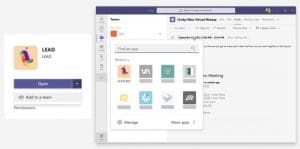Being physically distant from your coworkers doesn’t imply a lack of close working relationships. Thanks to recent advancements in communication technology, it is now possible to build cohesive teams and organizations comprising employees from across different regions, nationally or globally.
Business silos occur when departments within an organization work in isolation, impeding collaboration and knowledge sharing. This isolation can lead to an adversarial stance among teams, hindering overall productivity. To tackle this challenge, it’s crucial to foster casual meet-ups among employees from different teams, fostering a sense of unity and shared purpose.
With the introduction of LEAD.bot’s cross-team matching feature, breaking down these business silos and enhancing organization change management and enterprise employee engagement becomes an attainable goal. LEAD.bot for Microsoft Teams is specifically designed to streamline collaboration among various teams, enabling a smooth, efficient, and effective virtual team-building process. By promoting interaction with international branches, this tool helps organizations foster a globally-minded work culture.
The use of such software brings significant benefits for HR personnel and managers. It facilitates easy management of virtual teams, encourages knowledge sharing, increases employee engagement, and ensures that no team works in isolation. So, don’t miss the invaluable learning opportunities provided by having diverse teams and embrace the power of virtual team building with LEAD.bot.

Cross-team collaboration can also start with the onboarding process. Being a new hire is tough, especially during a pandemic when they can’t meet their new team members in person. To make the transition smoother, try integrating cross-team collaboration into the onboarding process. Consider a mentorship program by matching groups of new hires with veteran employees, or have new employees learn how the workplace functions by matching them with people from different departments every week.
Whether it be virtual onboarding or just wanting to boost teamwork, read on to learn how matching employees across teams can improve your org’s productivity.
The Hidden Benefits of Employee Matching Across Teams
Promoting cross-team relations might seem unintuitive. After all, there doesn’t seem to be much of a reason to promote cross-team learning if the two teams are not directly related. However, there are great boons to introducing your team members to their counterparts in different regions or areas of expertise.
First and foremost, your employees gain a valuable perspective when they meet other branches of your organization because it prompts them to look at their work from another angle. For example, tech teams might learn from non-tech teams because they see their products from the perspective of a layperson. Introducing teams from two different regions can also open their eyes to new tactics and strategies that each team can then apply to their own work.
Crucially, the process of cross-team matching plays an integral role in remote onboarding, fostering a swift and effective integration of work-from-home hires into the organizational fabric. Remote work can change the typical onboarding checklist. The team can’t casually take the new members out to lunch as they might have before, but that doesn’t mean new hires have to be left in the dark. Matching new employees with more experienced members of the team through a formal mentorship program or even informal coffee chats provides a valuable chance for new folks to learn about the org and how it works. In fact, remote onboarding might even give new hires the opportunity to interact with colleagues whom they might have never crossed paths with in the office.
For global teams, communication across borders can give employees a deeper cultural understanding because they get the chance to learn about and then respect other cultures. Through this process, learning how to communicate with people from all around the world makes employees more open-minded and empathetic.
The Institute of International Education found that those who’ve studied abroad have greater flexibility, adaptability, self-awareness and intercultural skills. While connecting with another team isn’t exactly the same, the team will earn some of these important skills when exposed to new concepts.
Connecting Teams

Connecting teams may also combat some of the challenges people often have in global organizations. It’s no surprise that studies have found that global teams’ biggest challenges are feeling a lack of trust and having trouble communicating. After all, it’s hard to gauge a coworker you’ve never really met. When managers schedule social meetups in addition to professional ones, their team members can get to know each other in a more personal capacity and start to see themselves as part of a team.
In organizations where teams feel disconnected, workers can easily fall into a silo mentality. Silos develop when departments are too isolated and employees take adversarial stances against other teams. The reluctance to share information and collaborate hinders productivity and kills healthy company cultures. Encouraging different teams to work with one another and learn from each other combats silo mentality, boosting employee engagement, collaboration, and creativity.
While trust may seem like a pretty abstract term, it has real-life consequences. Compared to companies where levels of trust were low, employees of high-trust companies reported 74% less stress, 106% more energy at work, 76% more engagement and 40% less burnout, according to the Harvard Business Review.
Promote structures and programs for cross-team learning and trust-building with some of our ideas below.
Connecting Your Teams
Cultivating long-lasting, meaningful relationships in the workplace is an ongoing, progressive process, not a one-time endeavor. It’s actually the small moments, like water cooler conversations or coffee chats, that build up over time. Plus, every remote team is different – what works for one department may not work for another. Luckily, there are all kinds of team-building activities available remotely and are made even easier with a company culture-building app like LEAD.app.
Consider creating a “virtual lounge” for non-work-related fun. It can be as simple as making a team or channel titled “random” that acts as a virtual bulletin board for jokes, cool news articles or fun opportunities. You can also invite team members to make teams or channels that cater to their own interests – for example, a football channel, a travelling or hiking channel, or even a channel for fans of TV shows like The Bachelor.
Virtual lounge works great for global teams since employees can share their culture and learn about others in a casual, relaxed way. Even though these may seem like a silly or trivial part of the workday, bringing in common ground and a bit of fun goes a long way for remote team building. In addition to building that all-important trust, team building facilitates communication and collaboration.
Employee relations can often become an afterthought – but according to Deloitte, 94% of companies say that agility and collaboration in teams are the keys to success.
Cross-Country Employee Matching
Managers can also pair off members of different teams to make cross-country employee matching. For example, managers can create ‘international work buddies’ by pairing members of the London marketing team with the Tokyo marketing team members. This program could simply be about fostering friendship, or it could provide a serious language-learning or skill-sharing opportunity.
Adam Traidman, CEO of BRD, found that LEAD was a great tool for growing companies where employees might not all be working in the same place.

Remote work means that companies no longer have to hire locally – with a virtual onboarding experience, new remote workers can build relationships in the workplace from thousands of miles away. Cross-country employee matching can help integrate all workers into the virtual office, no matter how far away they are physically.
Virtual Happy Hours
Virtual happy hours are also a great way of getting employees to know each other. Studies show most remote employees feel that they don’t get enough time to really meet their colleagues in business meetings. Setting aside an hour or so is a simple way for your employees to make new friends. For international teams with different time zones, a shared meal or coffee would be an easy alternative to drinking cocktails at odd hours.
Virtual happy hours and virtual coffee are especially vital for new hires to get to know each other in the remote onboarding process. Helping new team members build relationships from day one will help improve their work environment as well as the overall employee experience. Plus, coffee breaks, even on Zoom, can help break up the monotony of meetings and training sessions and make new hires’ virtual onboarding experience feel more human.
How LEAD.bot can help your teams
The company culture app, LEAD.bot, simplifies the process of unifying teams within Microsoft Teams, presenting an intuitive solution for fostering organizational unity. LEAD.bot can help you host virtual happy hours, learning programs, virtual onboarding processes, and more! Using LEAD.bot is super easy – all you have to do is add it to your organization and join the team it automatically creates. Once all participating employees join the team too, LEAD.bot will pair up employees in the Team, and create a private message with those matches. LEAD.bot will send off new matches every week and also send a follow-up reminder for old matches to meet up.
You can see a sample of this message in the graphic below or check it out for yourself by adding it to Teams for free!
LEAD.bot even cross-matches teams to break down business silos. Just add the bot to the two Teams you want to match, and access the dashboard to control the settings for cross-team matching. Other settings include customizing how many employees per match and how often new matches are sent out. Plus, the app automatically collects feedback so you can tweak your employee matching program to best match your company culture.
In practice, you could match employees from abroad with domestic employees, teams from two different fields like HR and engineering, or just match employees that have the same interests regardless of where they’re from. The possibilities are endless – the only limit is your organization’s eagerness to collaborate.
To learn more about LEAD for Microsoft Teams, check us out at LEAD.app.







